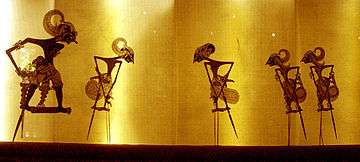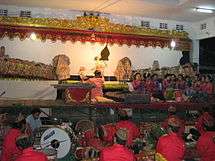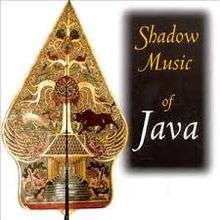Wayang Kulit Indonesia

Wayang Kulit is a type of traditional puppet-shadow play that originated in India and is now performed in Indonesia. The Indonesian word "wayang" is derived from a word meaning shadow or ghost, while Kulit means leather or skin.
Wayang Theatre in Indonesia comes in many different forms (Beber, Kelitik, Kulit, Golek, Topeng, Wong). Wayang Kulit is among the best known, offering a unique combination of ritual, lesson and entertainment. The classic form is named Wayang Purwa.
Lacy shadow images are rear-projected on a taut linen screen with a coconut-oil or electric light. The Dalang (shadow artist) manipulates carved leather figures between the lamp and the screen to bring the shadows to life. Wayang Kulit is often performed during wedding celebrations, especially in Java.
There are important differences, between the 3 Islands where Wayang Kulit is played (due to local religious canon) : [1] [2]
- in Java (where Islam is predominant), the puppets (named "ringgit") are elongated, the play lasts all night and the lamp (named blencong) is, nowadays, almost always electric. A full Gamelan with (pe)sinden is typically used.[3]
- In Bali (where Hinduism is predominant), the puppets look more real, the play last a few hours and, if at night, the lamp uses coconut oil. Music is mainly by the four "Gender" wayang, with drums only if the story is from the Ramayana . There are no sinden. The Dalang does the singing.
Balinese dalangs are often also priests (amangku dalang). As such, they may also perform during daylight, for religious purposes (exorcism), without lamp and without screen (wayang sakral, or "lemah")[4] - In Lombok (where Islam is predominant and Bali's influence is strong), vernacular Wayang Kulit is known as Wayang Sasak, with puppets similar than Javanese ringgits, a small orchestre with no sinden, but flutes, metallophones and drums. The repertoire is unique to the Island and is based on the Muslim Menak Cycle (adventures of Amir Hamzah).
See the gallery below, where the Mahabarata character shown is Kresna (all pictures, except the last one)
-

Central Java ringgit
-

Carving the leather, in a Jogyakarta factory
-

Painting the Ringgit, in a Jogyakarta factory
-

All stages of the making of a ringgit
-

Bali ringgit
-

In the specialized village of Sukawati, Bali
Components
Wayang Kulit shows involve the Dalang (puppeteer), Gamelan (traditional orchestra), Sinden (singers) in Java and Wayang (puppets).
Dalang
The Dalang sits behind a cotton screen with a light source above him. Softwood logs, traditionally made of banana wood, are placed between the puppeteer and the screen. During the performance, the dalang can stick the rods of the puppets into the soft wood, holding them in place. To the right of the dalang sits the puppet chest, which the dalang uses as a drum during the performance, hitting it with a wooden mallet. Usually (in Java), he has a cymbal-like percussion instrument at his feet that he uses for emphasis or to cue musicians.
Gamelan (in Java)
Gamelan is an orchestra consisting of bowed stringed instruments, flutes and a variety of percussion instruments. The musicians are the Niyogo. It is the traditional ensemble music of Java and Bali. The most common instruments used are metallophones played with mallets and a set of hand-played drums called kendhang, which keep the beat.
Many styles of Gamelan instruments and music exist in Indonesia. Each area takes its own approach to accompaniment evolving from similar roots.
The repertoire typically consists of an overture, music for traveling, character pieces and battle music.
Sinden (in Java)

The singers are divided into Pesinden (female singers) and Wirasuara (male singers).

Wayang
The wayang comes in sizes from 25 cm to 75 cm. The important characters are usually represented by several puppets each. The wayang is usually made out of water buffalo and goat hide and mounted on bamboo sticks. However, the best wayang is typically made from young female buffalo parchment, cured for up to ten years. The carving and punching of the rawhide, which is most responsible for the character's image and the shadows that are cast, are guided by this sketch. A mallet is used to tap special tools, called tatah, to punch the holes through the rawhide. Making the wayang sticks from horn is a complicated process of sawing, heating, hand-molding, and sanding until the desired effect is achieved. When the materials are ready, the artist attaches the handle by precisely molding the ends of the horn around the individual wayang figure and securing it with thread. A large character may take months to produce.
Performance
Wayang shadow plays are usually tales from the two major Hindu epics, the Ramayana and Mahabharata. The puppet master contextualizes stories from the plays, making them relevant to current community, national or global issues. Gamelan players respond to the direction of the Dalang.
Etymology
"Wayang" derives from a word meaning "shadow" or "ghost", in turn originating from two ancient words: "Waya" meaning "ancestor or descending", and "Ang" meaning "symbol". Another source is the phrase "Ma Hyang", meaning spirit, God or God Almighty.
Wayang, in modern Indonesian language, is loosely translated to mean puppet. Kulit means skin or leather, the material from which the figures are carved.
History

Hinduism arrived in Indonesia from India before the Christian era. Sanskrit became the literary and court language of Java and later of Bali.
The Hindus changed the Wayang (as did the Muslims, later) to spread their religion, mostly telling stories from the Mahabharata or the Ramayana. This mixture of religion and wayang play was later praised as harmony between Hinduism and traditional Indonesian culture.
When Islam began spreading in Indonesia, the display of God or gods in human form was prohibited, and thus this style of painting and shadow play was suppressed. King Raden Patah of Demak, Java, wanted to see the wayang in its traditional form, but failed to obtain permission from Muslim religious leaders.
Religious leaders attempted to skirt the Muslim prohibition by converting the wayang golek into wayang purwa made from leather and displayed only the shadow instead of the puppets themselves.
See also
References
- ↑ Art in Indonesia, Continuities and Changes - Claire Holt - Cornell University Press
- ↑ Das Indonesische Schattenspiel - Guenter Spitzing- Dumont Taschenbuecher
- ↑ On thrones of Gold, Javanese Shadow Plays - James R. Brandon - Harvad University Press
- ↑ Religion in Bali, by C. Hooykaas, University of Leiden
- ↑ Shadow Music of Java. Rounder CD 5060
Sources
- "Bali & Beyond Educational Resources". www.balibeyond.com. Retrieved 2016-05-21.
- "About wayang kulit". Kanda Buwana: Wayang Kulit Puppet Theatre. 2010-06-13. Retrieved 2016-05-21.
- "Wayang Kulit - a shadow play". minyos.its.rmit.edu.au. Retrieved 2016-05-21.
- "History of Wayang Kulit - Wayang". shadowtheatre-ika.blogspot.co.id. Retrieved 2016-05-21.